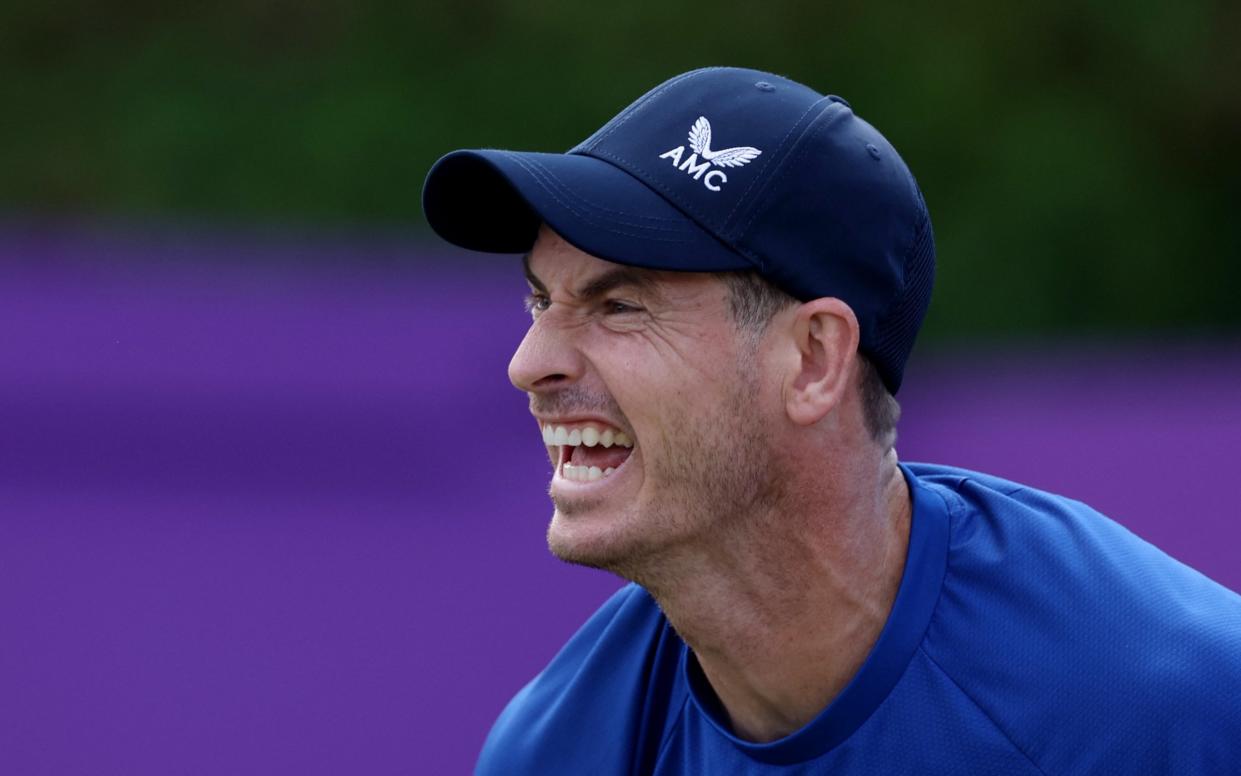Andy Murray’s compulsion to compete verges on the irrational

Perhaps the most remarkable part of Andy Murray’s “dead leg” drama at Queen’s Club on Wednesday was how unfazed he seemed by the whole business.
If you or I had felt our right leg suddenly lose “coordination, control and strength” out of nowhere, a sense of panic might understandably have set in.
From Murray’s matter-of-fact demeanour in the interview room, though, it seemed as though this was just another day at the office.
Asked how he saw his chances of playing Wimbledon – a tournament that starts in less than a fortnight – he pointed out that all his recent treatment had focused on the left side of his back.
The unstated implication was that, with a bit of attention to the right side, perhaps including a painkilling or anti-inflammatory injection, the problem might very well clear up.
The whole interview was a window into a world of pain. It revealed how normalised this sort of experience has become in Murray’s life. And how his compulsion to compete can sometimes verge on the irrational.
Back pain, lest we forget, has been a constant for almost 15 years. And yet, he seems able to shut out the suffering as easily as a light sleeper popping in their earplugs.
The hips started to give out somewhere after his second Wimbledon title in 2016. And still he defied medical opinion, becoming the first man to maintain a tour-level singles career with a metal hip.
However rocky Murray’s path has looked from courtside – and it has seemed pretty rugged at times – the reality has unquestionably been worse.
Asked on Wednesday how he has dealt with his most recent setbacks – which included the rupture of two ankle ligaments in late March – he dropped his poker face for a second.
“Although the last few years might have seemed OK, it’s been hard, it’s been really hard on the body,” Murray admitted. “A lot of days where it’s not been that much fun to train and practise and everything.
“I have tried to work through it, find ways to get on the court and compete at this level. But tennis is a really, really hard sport. As you start to age, your body has got a lot of wear and tear in it. All tennis players, we have degenerative sort of joints and stuff in the back.”
As fans of British tennis, we all have reason to be grateful for Murray’s extraordinary resolve. He was born with a bipartite patella (a congenital condition where your kneecap is split into two pieces), while his hip issues suggest that he may have developed dysplasia (an overly shallow hip socket) somewhere along the line as well.
But none of this stopped Murray from dishing out 29 victories over the so-called Big Three (Roger Federer, Rafael Nadal and Novak Djokovic) or from working like a beast every day in the gym. It didn’t stop him from setting the ultimate example to his British team-mates, and even carrying them to the Davis Cup trophy in 2015.
The bigger question is why he continued to fight so hard once the glory faded, and the spotlight moved on to younger men.
Yes, Murray loves to prove people wrong, and by making a viable career out of tennis with a metal hip, he has unquestionably done that. But there never seemed to be much satisfaction in reaching the second round of a major, when he used to routinely forge through to the semi-finals or better.
Where does this almost masochistic motivation come from? At the risk of playing amateur psychologist, it feels as if it must be drawn from some dark place within his psyche. In fact, Murray admitted as much during the “Resurfacing” documentary that he released in 2019.
“My feeling towards tennis is that it’s an escape for me in some ways,” he said, mentioning a range of traumatic events that befell his family between the Dunblane school shooting of 1996 and his parents’ divorce a year later. “Tennis allows me to be that child, that has all of these questions.”
For Murray, it seems, physical pain has always been more bearable than the emotional variety. But there has to be a limit, even for him. His many admirers will pray that he can walk out for one final match at Wimbledon, then find his way to a peaceful retirement.
For tennis as a whole, his struggles should serve as a cautionary tale. Are best-of-five-set matches really sustainable over the long term? Hasn’t the pace and intensity of the game reached the point where players’ health is inevitably being compromised? Remember that the format was devised in the 1870s, at a time when ladies wore crinolines and gentlemen rarely moved faster than a walk.
One hopes that Murray can enjoy his post-tennis life without the sort of inescapable daily pain that afflicts so many rugby players. For a non-contact sport, however, such crippling levels of wear and tear feel extreme.
We are already seeing the next generation – men like Carlos Alcaraz and Jannik Sinner – picking up injuries with worrying regularity. Perhaps the time has come to look at the demands of this apparently genteel sport. No one wants the greats to go limping out of the game.

 Yahoo News
Yahoo News 
